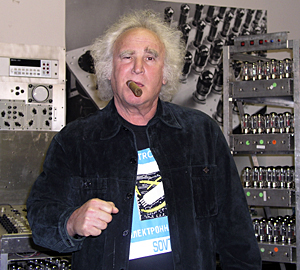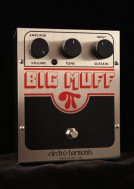Mike Matthews’ Story
 Electro-Harmonix was founded back in 1968 by musician Mike Matthews who studied electrical engineering at Cornell University. At the brink of EH, he was playing keyboard and promoting shows for bands like The Byrds, Isley Bros, Turtles and The Mamas & The Papas. He had a job at IBM in sales but had the same desire as all musicians, he wanted to play! In 1967, Mike got a contract to build a new version of a two transistor fuzz called the Foxey Lady by Guild. No doubt, Hendrix was a huge influence on the music world especially with Matthews who had seen him back as Jimmy James with Curtis Knight & the Squires. He was looking for a way to make some good money so he could lose the day job and keep playing. So his first goal was to create something players were looking for, clean sustain. This turned out to be not as easy as planned but while working with help from Bob Myer of Bell Labs, they unexpectedly came up with a gem. A simple booster effect, originally designed to compliment their project at hand gave an extra gain stage to an amp, creating overdrive. The Linear Power Booster or the LPB-1, was a simple effect (one transistor and few caps and resistors), which contributed to the start of an effect pedal craze. Mike recalls people lining up that year at the ’68 NAMM show to order his product. So that was reason enough to quit IBM and he continued to tinker with many variations of the circuit under funky names like The Mole and the Screaming Tree, a technique Electro-Harmonix still practices to this day.
Electro-Harmonix was founded back in 1968 by musician Mike Matthews who studied electrical engineering at Cornell University. At the brink of EH, he was playing keyboard and promoting shows for bands like The Byrds, Isley Bros, Turtles and The Mamas & The Papas. He had a job at IBM in sales but had the same desire as all musicians, he wanted to play! In 1967, Mike got a contract to build a new version of a two transistor fuzz called the Foxey Lady by Guild. No doubt, Hendrix was a huge influence on the music world especially with Matthews who had seen him back as Jimmy James with Curtis Knight & the Squires. He was looking for a way to make some good money so he could lose the day job and keep playing. So his first goal was to create something players were looking for, clean sustain. This turned out to be not as easy as planned but while working with help from Bob Myer of Bell Labs, they unexpectedly came up with a gem. A simple booster effect, originally designed to compliment their project at hand gave an extra gain stage to an amp, creating overdrive. The Linear Power Booster or the LPB-1, was a simple effect (one transistor and few caps and resistors), which contributed to the start of an effect pedal craze. Mike recalls people lining up that year at the ’68 NAMM show to order his product. So that was reason enough to quit IBM and he continued to tinker with many variations of the circuit under funky names like The Mole and the Screaming Tree, a technique Electro-Harmonix still practices to this day.
Big Muff and Beyond
The Big Muff Pi has been mistakenly said to be produced in 1971, but we know from Mr. Matthews that Hendrix bought an early version of the Big Muff in NY, from Manny’s Music around 1969. Whether it was used on his recordings is another story. Matthews and Myer improved the design of the early Muff Fuzz, getting closer to the idea of cleaner sustain without the “raspyness.” It used 4 transistors and a set of capacitors to filter out harsh frequencies. The resulting violin like tone can be heard along with other EH effects on The Wall and more recently by The White Stripes. After the huge success of the Big Muff Pi, EH worked on a variety of other effects like the Small Stone phase shifter. The Stone offered a unique circuit at a price below companies like MXR. This philosophy of affordable effects remains with EH to this day.
 The first versions were nicknamed Triangle Muffs due to their control layout.
The first versions were nicknamed Triangle Muffs due to their control layout.
The 70’s saw more wacky names and creative effects like The Octave Multiplexer, Golden Throat talk box, and Frequency Analyzer ring modulator. By the way, distortion-free sustain was eventually released in the form of the Black Finger compressor in the early 70’s and more recently with a tube version. Then about 1977 came one of the most in demand and affordable delay pedals to hit the masses, the Memory Man. Based around a quieter Panasonic bucket brigade device, this pedal was able to produce lush, organic repeats without moving parts (solid state). You can get a big taste of this pedal in U2’s 1980 album, Boy, which used the Deluxe Memory Man version including chorus/vibrato for an extra syrupy sound.
Digital Era
In the early 80’s, the supply of Panasonic BBD’s were scarce but the digital era enabled EH to carry on with the first mass market Digital Delay created by David Cockeral. The Two-Second Digital Delay was a major milestone and led to a creative twist, the 16 second Digital Delay in ‘82, a looper unit still used by the adventurous guitarist Nels Cline. Of course looping would take off into something larger than Matthews’ simple idea of jam along with yourself.
The rare Red Army Overdrive was the first pedal produced by Sovtek, later repackaged as the Green Russian Big Muff.
Future of EH
The demand for vintage stompboxes brought back the Electro-Harmonix name with both classic pedals and ones that continue to break new ground. Such gems you may be familiar with are the POG, Cathedral Reverb and analog/digital versions of the Memory Man. Even the ol’ Muff is re-evaluated and analyzed to be constructed into creations like the Metal Muff and now in 2010, the Germanium 4 Big Muff Pi. Mike Matthews has certainly come a long way from a simple transistor booster. It is truly inspiring to see a company influence the coming generations of musicians, not to mention an owner still enthusiastic about his products (check out Mike and his son having fun with the 22 Caliber on YT) . Well, there’s your bit of history for the day, now go play something!
Russian Era
Shortly after digital effects and companies like Boss dominated the market in the early 80’s, Electro Harmonix would run into financial hardships and close their doors. It wasn’t until the late 80’s when Mike Matthews started up New Sensor Corp that reissues of famous effects like the Big Muff and Small Stone would be seen. Matthews seized the opportunity to produce pedals at a lower cost by using former Russian military factories that were in need of work. Other products under the name Sovtek were produced through the 90’s including amps, microphones and still, vacuum tubes. So, if you ever wondered what your green Big Muff was doing in Russia, the answer is simply, cost effective production.

